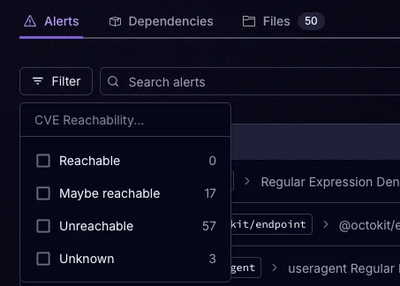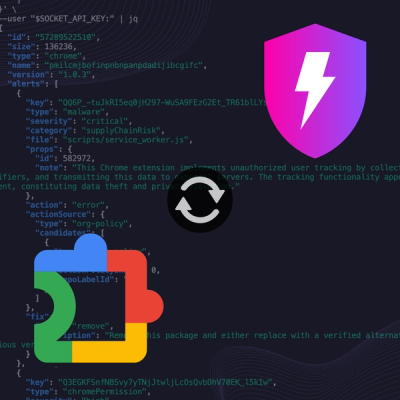
Product
Announcing Precomputed Reachability Analysis in Socket
Socket’s precomputed reachability slashes false positives by flagging up to 80% of vulnerabilities as irrelevant, with no setup and instant results.
Expflow is a Python library that controls the flow and handles the data of psychological experiments. While it isn't a full-fledged experiment builder like PsychoPy, it may be used with other tools to create robust experiments with minimal coding.
Expflow is available on PyPI and can be installed in the typical way with pip:
pip install expflow
Expflow has strong opinions about how psychological experiments should be structered and coded, and performs extensive automatic bookkeeping and numerous validation checks under the hood to ensure that the user's code is consistent with these opinions.
Expflow defines an experiment as a sequence of trials presented to a participant. Typically, trials are identical except for a small number of critical details, such as the stimulus. The participant makes a response on each trial, after which the trial ends. The next trial begins after the previous one. After the last trial, the experiment is finished.
Expflow makes extensive use of the logging module. The first few times you use expflow, I recommend setting up basic logging at the most verbose level at beginning of your experiment script, which will allow you to see exactly what expflow does. If blazing fast performance is not a major concern — which typically it isn't, because psychological experiment are often simple things and modern computers are powerful — you could leave verbose logging switched on all the time (that's what I do).
import logging
logging.basicConfig(level=logging.DEBUG)
logging.debug("Hello, world!")
The rest of this tutorial will now print many log message to the console.
Import expflow as follows.
import expflow
See the bit about creating a temporary directory in the log output?
Expflow needs somewhere to store data right away, and the default behaviour is to use a temporary directory. This is suitable for testing, but a bad idea for real work, because the data you generate will be lost when the program ends. Expflow will bug you with warnings if you don't set a permanent data directory. For example, try this:
expflow.get_expflow_dir() # produces a warning
To set a permanent directory, use the set_expflow_dir function. You can pass any valid writable path to a directory. A
good choice is a dedicated subdirectory of your home directory. For convenience, expflow provides this as a constant
called expflow.USER_DIR.
expflow.set_expflow_dir(expflow.USER_DIR) # set a dir
expflow.get_expflow_dir() # prints something like `/Users/username/Expflow`
The function set_expflow_dir creates several subdirectories if they don't already exist. These are used to store
different types of data. Currently, participant data are stored in the participants subdirectory and experiment data
are stored in the experiment subdirectory. The others will be used by future versions of expflow.
Before we go on, let's take a moment delete some files that may exist in your user directory if you ran this tutorial previously.
for i in range(1, 10):
(expflow.USER_DIR / "Participants" / f"example_p{i}.json").unlink(True)
(expflow.USER_DIR / "Experiments" / f"example_p{i}.example_e1.json").unlink(True)
A participant is a person who takes part in an experiment. In expflow, a participant is represented by a Participant
object. You should create an instance of this class for each participant in an experiment.
p = expflow.Participant("example_p1") # creates a new participant
Participant objects are dataclasses. The single required argument
becomes a field called participant_id, which must be a unique string for each participant. Other optional fields you
can set are:
dob: Date of birth. Should be a date object.age: Age. Should be an int or float. Doesn't make sense to use this if dob is specified.gender: Participant gender.language: Participant language.comments: Any comments about the participant.group: Participant group.There are other fields as well. You can see them all like so:
import dataclasses
for field in dataclasses.fields(p):
logging.info(f"{field.name}: {getattr(p, field.name)}")
However, don't go changing the values of the other fields willy-nilly! Expflow manages them
automatically and uses them for bookkeeping. Generally, I recommend setting participant fields at object instantiation
and, except perhaps for the comments field, never changing them.
When we created our participant object, it automatically saved a JSON
representation of itself to a file in the participants subdirectory, whose path is given by the path field. This
will always happen every time we create a participant object and there is no way to stop it, by design. A participant
object will also save itself before garbage collection.
del p # delete the participant
This "autosaving" feature allows expflow to enforce Golden Rule #1: A given participant can't be created twice. An
exception will be raised if you try to create a new participant with the same participant_id as an existing
participant, even if the older participant was not created during the current Python session.
try:
p = expflow.Participant("example_p1") # even though we deleted `p`!
raise RuntimeError("You won't see this message")
except expflow.ParticipantExistsError as er:
logging.error(er)
Sometimes you may need to load a participant, for example to add something to their comments field. You can do so
using the load class method, which requires the participant_id.
p = expflow.Participant.load("example_p1")
p.comments += "- Here's a comment\n"
p.comments += "- Here's another\n"
del p # autosave on deletion
You can overtly save the participant with the save method, but you shouldn't need to. If you want to quickly get at
the participant data for testing or debugging purposes, you can use the to_dict and to_json methods. But otherwise,
participant objects will save on garbage collection.
By default, JSON representations of participants are uncompressed, but you can use gzip
compression instead by setting the optional field compression to True when creating a new participant or setting the
global variable expflow.using_compression to True to turn on compresson by default. Compressed files usually much
smaller, but not human readable, and have the extension .json.gz instead of .json.
Experiments are represented by the Experiment dataclass. You must create an instance of this class each time a new
participant is about to run an experiment. Experiment objects have two required fields: participant_id and
experiment_id.
e = expflow.Experiment("example_p1", "example_e1")
The combination of these identifiers must be unique. In other words, a single participant can perform multiple different experiments, and multiple different participants can perform the same experiment, but Golden Rule #2: A given participant can't perform a given experiment twice.. You can load an experiment object with an existing combination of identifiers.
del e
try:
e = expflow.Experiment("example_p1", "example_e1")
raise RuntimeError("You won't see this message")
except expflow.ExperimentExistsError as er:
logging.error(er)
e = expflow.Experiment.load("example_p1", "example_e1")
Under the hood, this is enforced by saving on creation and garbage collection.
You also can't create an experiment if the participant doesn't exist.
try:
_ = expflow.Experiment("example_p2", "example_e1")
raise RuntimeError("You won't see this message")
except expflow.ParticipantDoesNotExistError as er:
logging.error(er)
Finally, experiments have an optional user-specified field called trials, which is discussed in the next section. You
can set this on instantiation or later via special methods.
Experiments contain trials. Trials are represented by instance of the Trial dataclass, but unlike participant and
experiment dataclasses, they can't be saved or loaded individually (maybe in a future version). Expflow doesn't insist
on trials having unique identifiers or on required fields, either.
There are a number of optional fields:
stimulusresponsetrial_numberblock_numberconditionpracticeIt should be obvious what each of these is supposed to represent.
Let's create a list of trials.
trials = [expflow.Trial(trial_number=i) for i in range(3)]
Inside an experiment object, trials are stored in field called trials, which is a list of Trial objects. The
experiment we created currently has an empty trials field.
assert len(e.trials) == 0
This is a good time to bring up Golden Rule #3: Run experiments by iterating experiment objects. Accordingly, e
is iterable and its __len__ method returns the number of trials it contains.
assert len(e) == 0
We can append the trials we created to the experiment using the append_trials method.
e.append_trials(trials)
You can append to or otherwise directly modify e.trials but please don't, because the append_trials method does
extra things like checks you are actually appending Trial instances and saves the experiment object.
After appending, the experiment has three trials.
assert len(e) == 3
Experiments save themselves after a trial is appended, so if we delete the experiment and reload it, we will see that the appended trials are there.
del e
e = expflow.Experiment.load("example_p1", "example_e1")
assert len(e) == 3
Currently, there are only append_trials, append_trial, and insert_trial methods, but more may be added in future
versions of expflow.
This section will describe the core features that allows expflow to control experiment flow. First, it is important to know about two variables inside experiment objects: the trial index and the status.
Experiments have a field called trial_index, which is automatically managed. Its value is None on instantiation, and
becomes an integer when the experiment runs. Predictably, this is used to index the experiment's current position in
the trial list. User's shouldn't set this field themselves.
Experiments (and trials) have a special status property (mirrored by the current_status field). Users shouldn't set
this property or its field themselves, but they can read it or test its value with is_* boolean properties.
There are only six possible statuses and only certain status transitions are possible. The possible statuses, their meanings, and acceptable transitions are given in the table below.
| Status | Description | Acceptable transitions |
|---|---|---|
"pending" | Trial is scheduled to run later | running, skipped |
"running" | Trial is running right now | finished, timed_out, paused |
"paused" | Trial is temporarily paused | running |
"timed_out" | Trial went on too long and has ended | - |
"finished" | Trial ended as expected | - |
"skipped" | Trial will not run | - |
This is designed to conisistent with the common usage of the words. On instantiation, the status of an experiment is
always "pending". This is natural, because experiments are created before they are run. Pending experiments can be
changed to "running" or "skipped". Running experiments can be changed to "finished" if they were completed normally, "paused" if they were paused, or "timed_out" if they were timed out. Paused experiments must be unpaused (i.e., set back to "running") before they can be "finished". "finished", "timed_out", and "skipped" are terminal statuses. Hopefully this all makes intuitive sense.
Individual trials have a status property that behaves in exactly the same way.
As we shall see, experiment and trial statuses are managed automatically as we run an experiment. In fact, this is the major trick expflow employs to ensure proper flow.
As per Golden Rule #3, to run an experiment, you iterate over the experiment object, such as in a for loop.
def show_stimulus(stimulus):
"""Replace this with something that presents stimuli."""
pass
def get_response():
"""Replace this with something that collects responses."""
return "response"
for trial in e:
# do experimental stuff here, for example ...
show_stimulus(trial.stimulus)
trial.response = get_response()
# ... end of experimental stuff
if not e.is_running:
break
This is almost a completely normal Python for loop. I say almost because it contains an if statement that will
prematurely break the loop if the experiment status is no longer set to "running". This is necessary to catch pauses,
skips, and time outs (discussed later).
If your experiment is embedded within a larger program and it is not convenient or possible to use the for syntax,
you could use next(e) instead, but just remember to catch the StopIteration exception.
Notice that in our toy experiment above, the response field of the current trial was set to the participant's response
on that trial. How do we make sure those responses are recorded?
Each trial in the loop was a reference to the experiment's current trial (also available via self.current_trial).
Therefore, because we set trial.response to "response", participant responses are available after iteration (i.e.,
after the experiment has finished).
for trial in e.trials: # remember Golden Rule #3
assert trial.response == "response"
Furthermore, experiments save themselves after each iteration and status change, so we have also serialised the data as well. Let's delete the experiment object and reload it.
del e
e = expflow.Experiment.load("example_p1", "example_e1")
for trial in e.trials: # Golden Rule #3
assert trial.response == "response"
The responses were recorded! This is important — it means that expflow automatically stores data across Python sessions with no extra effort on the part of the user.
Suppose an experiment is too long to be completed all in one session: we need to pause it and resume it later. The following code simulates a pause halfway through an experiment.
p2 = expflow.Participant("example_p2")
trials = [expflow.Trial(trial_number=i) for i in range(10)]
e3 = expflow.Experiment("example_p2", "example_e1", trials=trials)
for trial in e:
if e.trial_index > 5:
show_stimulus(trial.stimulus)
trial.response = get_response()
else:
e.pause()
if not e.is_running:
break
assert e.is_paused
assert e.current_trial.is_paused
You can resume a paused experiment by iterating over it again.
for trial in e:
assert e.trial_index > 5
show_stimulus(trial.stimulus)
trial.response = get_response()
if not e.is_running:
break
Individual trials or entire experiments may have time limits. If so, you can use the trial.time_out and
experiment.time_out methods to time out a trial or experiment, respectively. Timed out trials and experiments cannot
be resumed (unlike paused trials).
Sometimes an experiment may skip upcoming trials, or an experiment may be skipped enitrely (if it is part of a batch of
experiments, for example). You can use the trial.skip and experiment.skip methods to achieve this. You can't skip a
trial or experiment that was already started, nor can you ever
start a skipped trial or experiment.
Experiments don't always present every trial to every participant. Sometimes an experiment may have a stopping rule,
where some or all remaining trials are skipped due to poor performance, or trial-specific or whole-experiment time
limits. The statuses "skipped" and "timed_out" — and their respecitve methods, skip and timeout (or time_out) — exist to deal with these circumstances. You can skip or time out individual trials or entire experiments. Skipped or timed out experiments/trials cannot be rerun afterwards under any circumstances.
Experiments and trials have a duration field that is calculated when the experiment/trial is finished or timed out.
It represents the total time taken to complete the experiment/trial, minus any time spent in a paused state, in seconds.
Expflow has a rudimentary crash-recovery feature. It doesn't work all the time, but it could save your bacon once in a while.
Consider this example:
p3 = expflow.Participant("example_p3")
trials = [expflow.Trial(trial_number=i) for i in range(3)]
e2 = expflow.Experiment("example_p3", "example_e1", trials=trials)
for trial in e3:
show_stimulus(trial.stimulus)
trial.response = get_response()
break # <- crash!
del e3 # <- crash!
e3 = expflow.Experiment.load("example_p3", "example_e1")
assert e3.is_paused
assert e3.current_trial.is_paused
Here, we have simulated a computer crash by breaking the trial loop and deleting our experiment object, which is approximately what would happen if you encountered an unexpected exception during your experiment. On garbage collection, an experiment object will change its status from running to paused if necessary, and save itself. Therefore, when this experiment is loaded again, it behaves as if it were paused at the point of garbage collection.
FAQs
A Python library for controlling the flow of psychological experiments.
We found that expflow demonstrated a healthy version release cadence and project activity because the last version was released less than a year ago. It has 1 open source maintainer collaborating on the project.
Did you know?

Socket for GitHub automatically highlights issues in each pull request and monitors the health of all your open source dependencies. Discover the contents of your packages and block harmful activity before you install or update your dependencies.

Product
Socket’s precomputed reachability slashes false positives by flagging up to 80% of vulnerabilities as irrelevant, with no setup and instant results.

Product
Socket is launching experimental protection for Chrome extensions, scanning for malware and risky permissions to prevent silent supply chain attacks.

Product
Add secure dependency scanning to Claude Desktop with Socket MCP, a one-click extension that keeps your coding conversations safe from malicious packages.